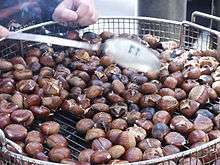Cookbook:Chestnut

Chestnut (Castanea) is a genus of eight or nine species of deciduous trees and shrubs in the Beech family Fagaceae, native to temperate regions of the Northern Hemisphere. They yield a hardwood as well as an edible fruit or nut.
Chestnuts' taste varies slightly from one to the next but is somewhat sweet and certainly unique. Chestnut-based recipes and preparations are making a comeback in Italian cuisine as part of the trend toward rediscovery of traditional dishes and better nutrition.
History
Chestnuts appeared in France in the 16th century. Parmentier, the famous potato promoter, extracted sugar from chestnuts and sent a chestnut sugarloaf of several pounds' weight to the Academy of Lyon. The continental blockade which followed shortly afterward (1806-1814) increased research into developing chestnuts as a source of sugar, but Napoleon chose beets instead.
Towards the end of 19th century, Lyon was brought low by the collapse of the textile market, notably silk, and Clément Faugier ingénieur des Ponts et Chaussées looked for a way to revitalize the regional economy. In 1882 at Privas, he invented the technology to make marrons glacés on an industrial scale, although a great deal of the over-twenty necessary steps from harvest to the finished product are still accomplished manually.
Uses
Chestnuts are used in sweet or savory recipes. They may be used to stuff vegetables, poultry, fowl and other edibles. They are available fresh, dried, ground, canned (whole or in puree), and may be eaten raw, candied, boiled, steamed, grilled, roasted, or fried (fritters).
Sweet Chestnuts are not easy to peel when cold. One kilogram of (untainted) chestnuts yields approximately 700g of shelled chestnuts. When peeled and eaten raw (almost unknown in North-America), they are somewhat astringent particularly if the pellicle is not removed.
Any method of cooking requires the fruit to be scored beforehand, otherwise the flesh expands and the fruit explodes. Once cooked its texture is similar to a baked potato, with a delicate, sweet, nutty flavor.
Roasting chestnuts does not involve peeling. The roasted fruit provides a coffee substitute.
Chestnuts can be dried and milled into flour, which may be used to prepare breads, cakes, pancakes, and pastas. It is the original ingredient for "polenta", known in Corsica as "pulenda." Chestnut flour is used to thicken stews, soups, and sauces. The flour from Castagniccia may be light beige, from other regions it's darker. It stores well over long periods and is nutritious. Chestnut bread keeps fresh for as long as two weeks.
Fermentation of the juice will make a beer. The juice may also make a fine granular sugar.
Candied whole chestnuts (candied in sugar syrup, then iced) are sold under the French name marrons glacés, or the Turkish name kestane şekeri ("sugared chestnuts"). Chestnuts are picked in autumn, and candied from the start of the following summer for the ensuing Christmas. Thus the marrons glacés eaten at Christmas are those picked the year before.